Have you ever seen a lingcod in person? These massive fish have a unique appearance. They are members of the greenling family Hexagrammidae and are the only extant members of the genus Ophiodon. In Washington State, these fish are very common. Anglers travel from all over the country in hopes of reeling in a record-breaking lingcod. Can you guess the size of the largest lingcod ever caught in Washington? Follow along to find out!
What is the Largest Lingcod Ever Caught in Washington?

On July 30, 1986, Tom Nelson caught a 61-pound lingcod while fishing on the San Juan Islands. The San Juan Islands are a popular spot for fishing. Multiple record fish have been caught in these waters, including the state record sand sole flounder that weighed 2.59 pounds.
About Lingcod
Lingcod are large fish that can live for up to 25 years. They are found on the west coast of North America. You can find them from the Shumagin Islands to Baja California, Mexico. Follow along to learn more about lingcods.
Description and Size
Lingcod are spotted grey, green, or brown fish. Their coloration helps them blend into their habitats. They are best known for their large mouths filled with 18 large, sharp teeth. Lingcods range a lot in size, but they can reach up to 5 feet long. The largest lingcod ever recorded weighed about 85 pounds.
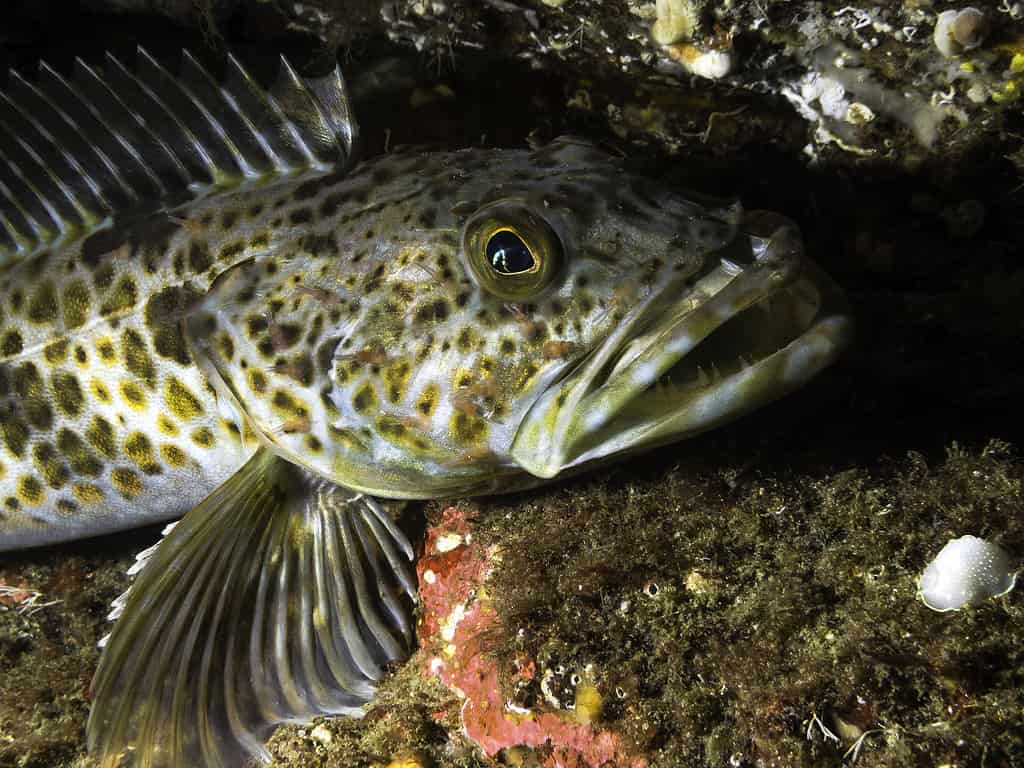
Lingcods are brown, grey, or greenish and spotted.
©naturediver/iStock via Getty Images
Distribution and Habitat
These fish are native to the western coast of North America. They live in depths of around 30 to 330 feet. However, they’ve been recorded in depths up to 1,000 feet. Most lingcods spend their time near rocky areas. Interestingly, these fish aren’t largely migratory. Instead, lingcods spend their entire lives in the same rocky habitats. They rarely have a reason to leave.
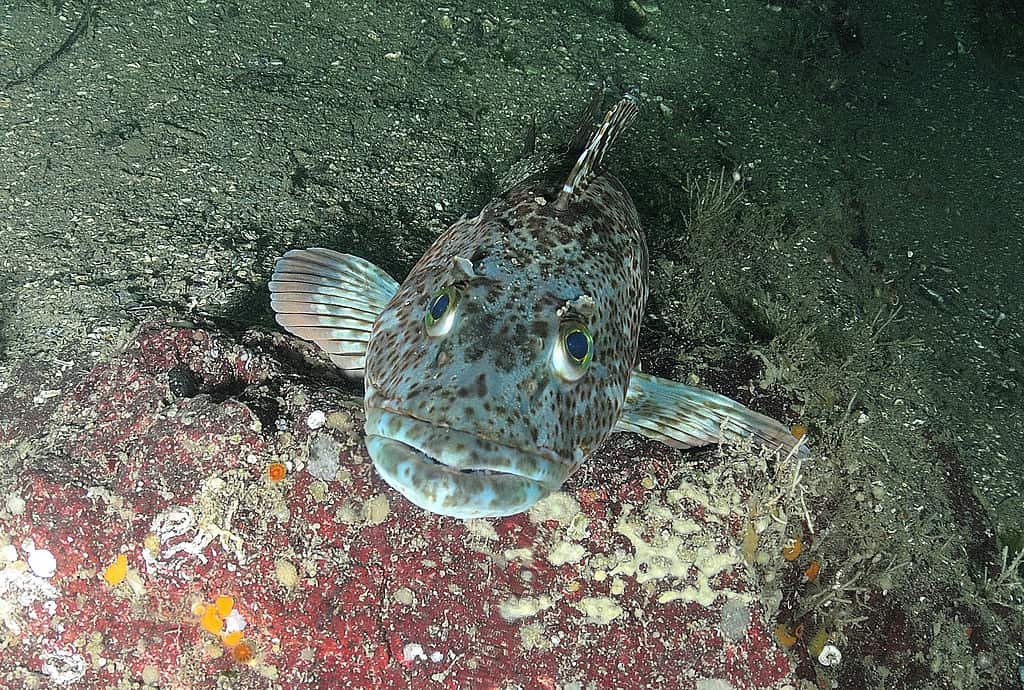
Lingcods mainly live in rocky areas at depths up to 330 feet, although some live as deep as 1,000 feet.
©Eduardo Baena/iStock via Getty Images
Diet
Lingcod fish aren’t picky eaters. They are voracious predators and eat just about anything that fits in their large mouths. Young lingcod mainly eat small fish, while larger mature lingcod eat anything from fish to squid. Adult lingcods may also eat other, smaller lingcods.
Predators
Lingcods have a large range of predators. These bottom-dwelling fish are often targeted by sharks, other larger fish, whales, and humans. To defend themselves, lingcods, bite, thrash, and chase. They’ve even been recorded chasing divers. Lingcods are very territorial during mating season. They also camouflage well with the ocean floor, often hiding from predators.
Fishing
Washington State is a fantastic place to catch lingcod. You can fish from the shore or in a boat in deeper waters. Lingcod is a delicious fish, often caught for cooking. Lingcod is described as mild in flavor and light. It tastes similar to cod, although lingcod is a greenling. You have a good chance of catching a mighty lingcod in the Puget Sound.
Other Washington State Fish
When fishing in Washington State, you aren’t limited to lingcod. There are well over a hundred fish species both along the coast and within the state. In this article, we aren’t going to just learn about the largest lingcod ever caught in Washington, but other fish species common in the state. Follow along to learn about other interesting fish species you may find in Washington and their state records.
Steelhead Rainbow Trout
Starting our list of other fish species in Washington State is the steelhead rainbow trout. The steelhead rainbow trout is an anadromous trout with a long range. You can find them across the cold-water tributaries of the Pacific Ocean in Asia and North America. These shimmering fish are generally silvery-brown with heavy spotting throughout their bodies. Their coloration though varies a lot depending on the specific subspecies. Most rainbow trout also have a reddish-pink stripe from the gills to the tail. Rainbow trout also vary in weight as some adults weigh as little as 1 pound. So, what’s the largest steelhead caught in Washington State? Technically, there are two record-holders. The largest though was caught by Gilbert Pierson in 1973. Gilbert caught a 35.06 summer-run steelhead in Snake River. The largest winger-run steelhead weighed 32.75 pounds. Gene Maygra caught the winter-run record in EF Lewis River in 1980.
There are also regular rainbow-trout records. For example, in 2002, Norm Butler caught a 29.60-pound resident rainbow trout. However, Richard L. Bates reeled in a 16.31-pound Beardslee trout in 1989.
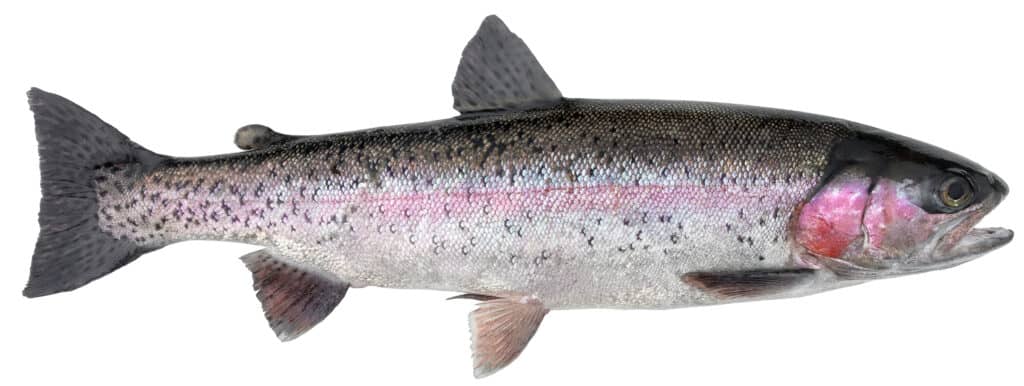
Steelhead trout have long, silvery bodies with a pink or red stripe running on their sides and black speckles.
©Edvard Ellric/Shutterstock.com
Yellow Perch
Next on our list of other fish in Washington State is the yellow perch. This small fish is native to large parts of North America.
Yellow perch fish go by many names. They are sometimes called striped perch and river perch. Yellow perch have fine small teeth. They are also slightly rough and easy to identify from their stripes. Not all yellow perch look the same. Some have bright green-brown or yellow-brown heads.
Yellow perch are striped fish that weigh about 4 to 10 inches long. They can also weigh up to 4 pounds and 3 ounces. The largest yellow perch caught in the world was 18 inches long, caught in 1965. It has held the title for nearly six decades. What about the largest striped perch in Washington? The largest yellow perch ever caught in Washington was 2.75 pounds. Larry Benthien caught this vibrant giant on June 22, 1969, in Snelson’s Slough in Skagit County.
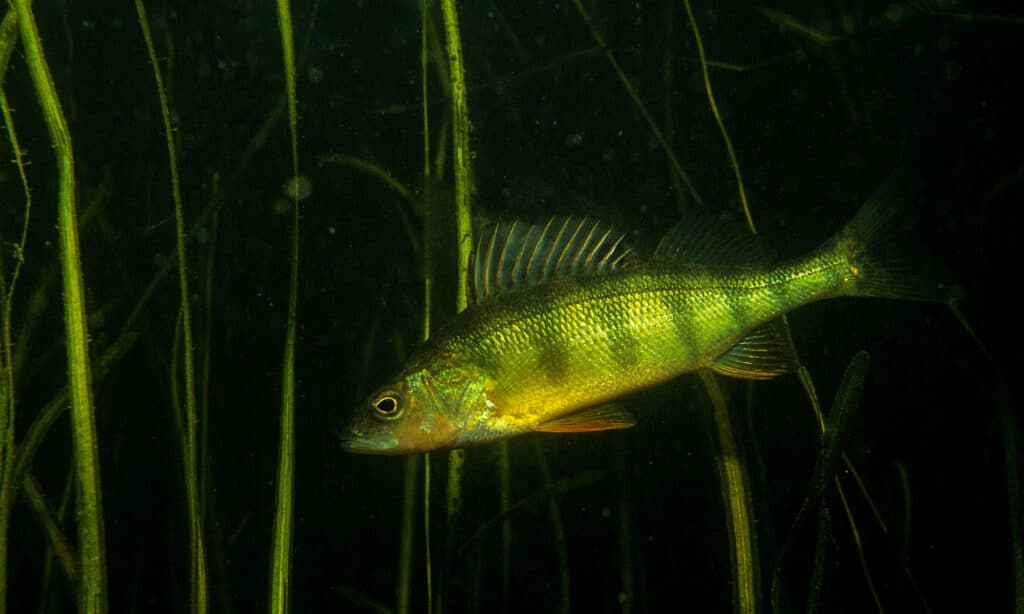
Yellow perch live throughout North America. They are small striped fish that can weigh up to about 4 pounds.
©RLS Photo/Shutterstock.com
Albacore Tuna
Also in Washington State is the albacore tuna. This tuna fish is a popular choice for many anglers. They are large tuna that are also called the longfin tuna. Albacore tunas are long fish with a conical snout and big, wide eyes. They also have silverish and dark blue bodies. Although albacore tunas are large, they are the smallest of the bluefin tunas. These fish though can easily reach 3 feet and 3 inches long and weigh as much as 80 pounds. However, the largest albacore tuna recorded was an astounding 4 feet and 7 inches long. The largest albacore tuna caught in Washington State wasn’t as large as the world record, but is still quite the catch! It weighed 52 pounds. Kurt Strickland caught this 52-pound tuna in 1997.
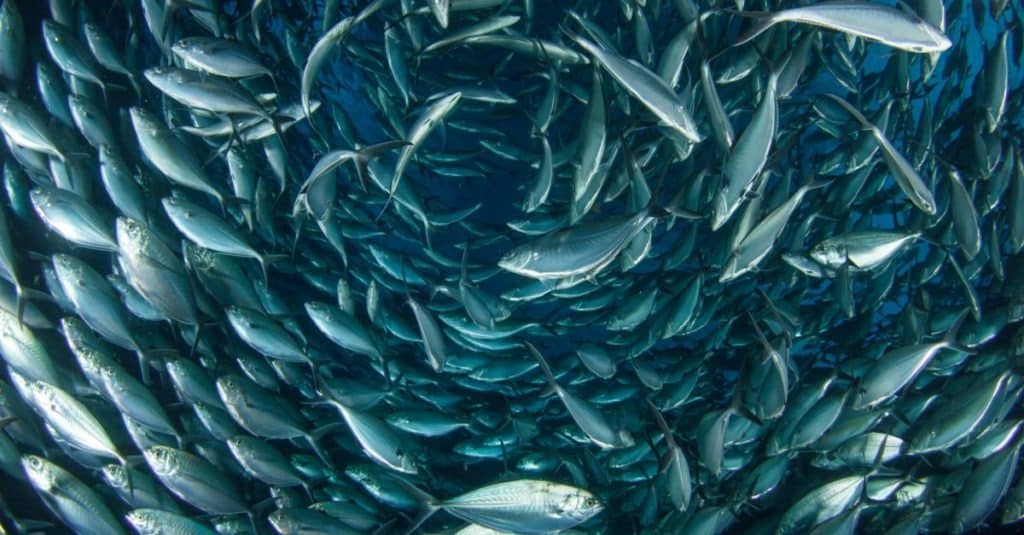
Albacore tunas can weigh as much as 80 pounds.
©Rich Carey/Shutterstock.com
Chinook Salmon
Another notable fish in Washington State is the Chinook salmon. The Chinook salmon is easy to identify from their unique face. They are the largest of the Pacific salmon. These massive and prized fish have large gaping mouths with a black gum line. They are also vibrant, with blue-green, silver-red, or purple bodies and silver sides. Chinook salmon also have dark spots on its upper body and tail. These unique fish can weigh as much as 130 pounds, although 10 to 50-pounders are more common. Chinook salmon are prized for their light and flavor. Their meat is either pink or white, depending on their diet. Mark Salmon likely enjoyed his state-record Chinook salmon. This angler, with a very fitting name, caught a 68.26-pound Chinook salmon in 1992 in the Elochoman River.
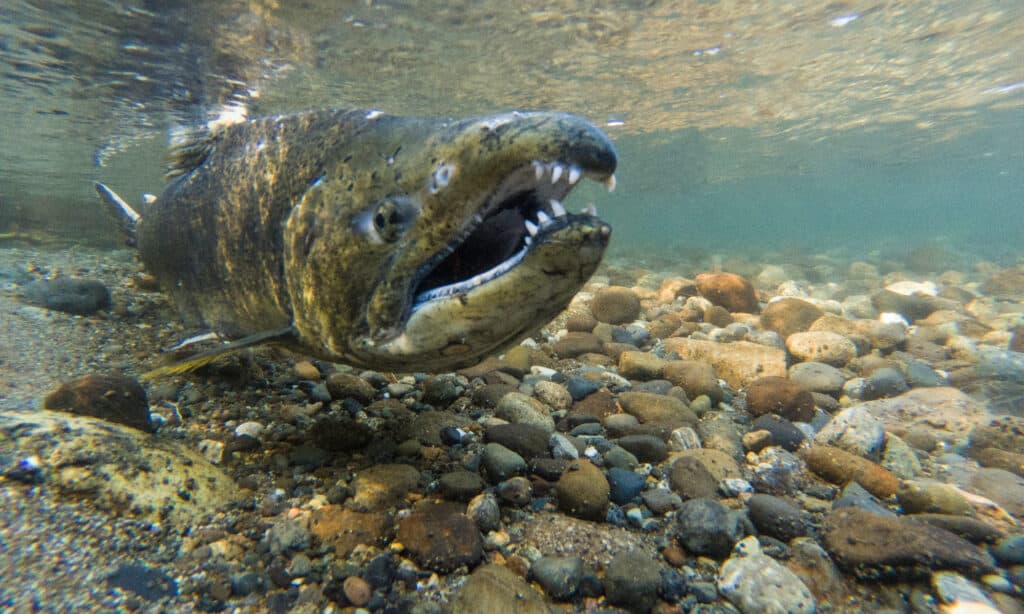
Mark Salmon caught the largest Chinook Salmon in Washington State. It weighed 68.26 pounds.
©Kevin Cass/Shutterstock.com
Starry Flounder
Last but not least is the starry flounder. These flat, but wide fish, are common in the North Pacific. They are unique fish with a black-to-dark brown side and a white-silvery side. They use their dark brown side to blend into the ocean floor, avoiding predators. Starry flounders have a wide range. You can find them off the coast of Japan and also in California and Alaska. While starry flounders can live in deep waters, they are typically found near shores. These fish can reach as much as 19 pounds, but this isn’t common. For instance, the largest starry flounder caught in Washington State weighed 9.5 pounds. Robert Walton caught this large fish in Pillar Point in 2009.
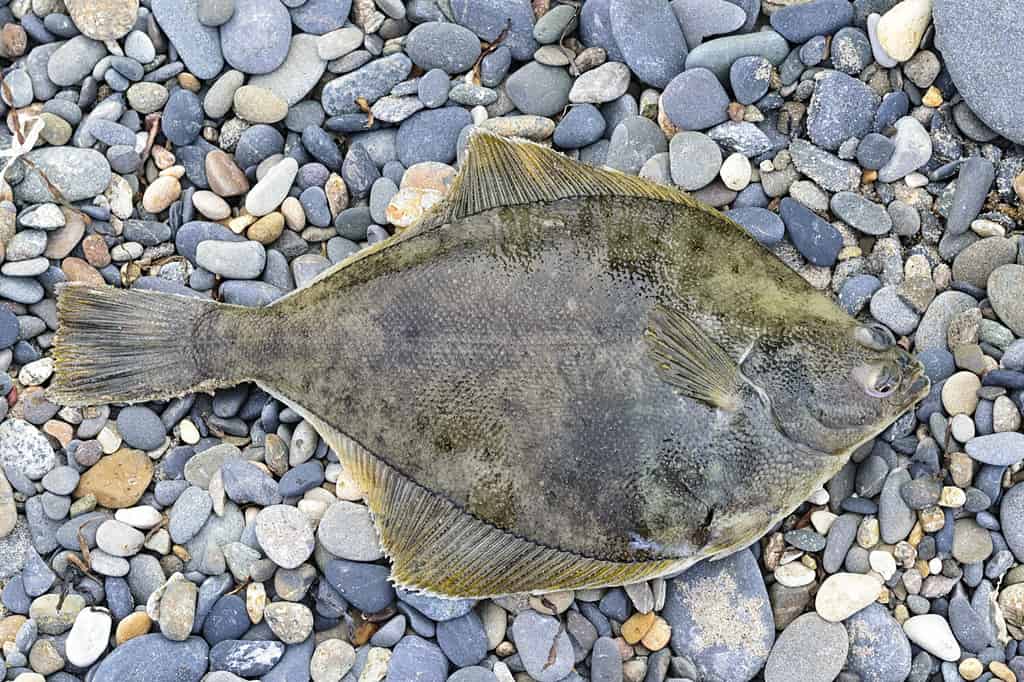
Starry flounders have a wide range.
©Konstantin Baidin/Shutterstock.com
The photo featured at the top of this post is © Joe Belanger/Shutterstock.com
Thank you for reading! Have some feedback for us? Contact the AZ Animals editorial team.






